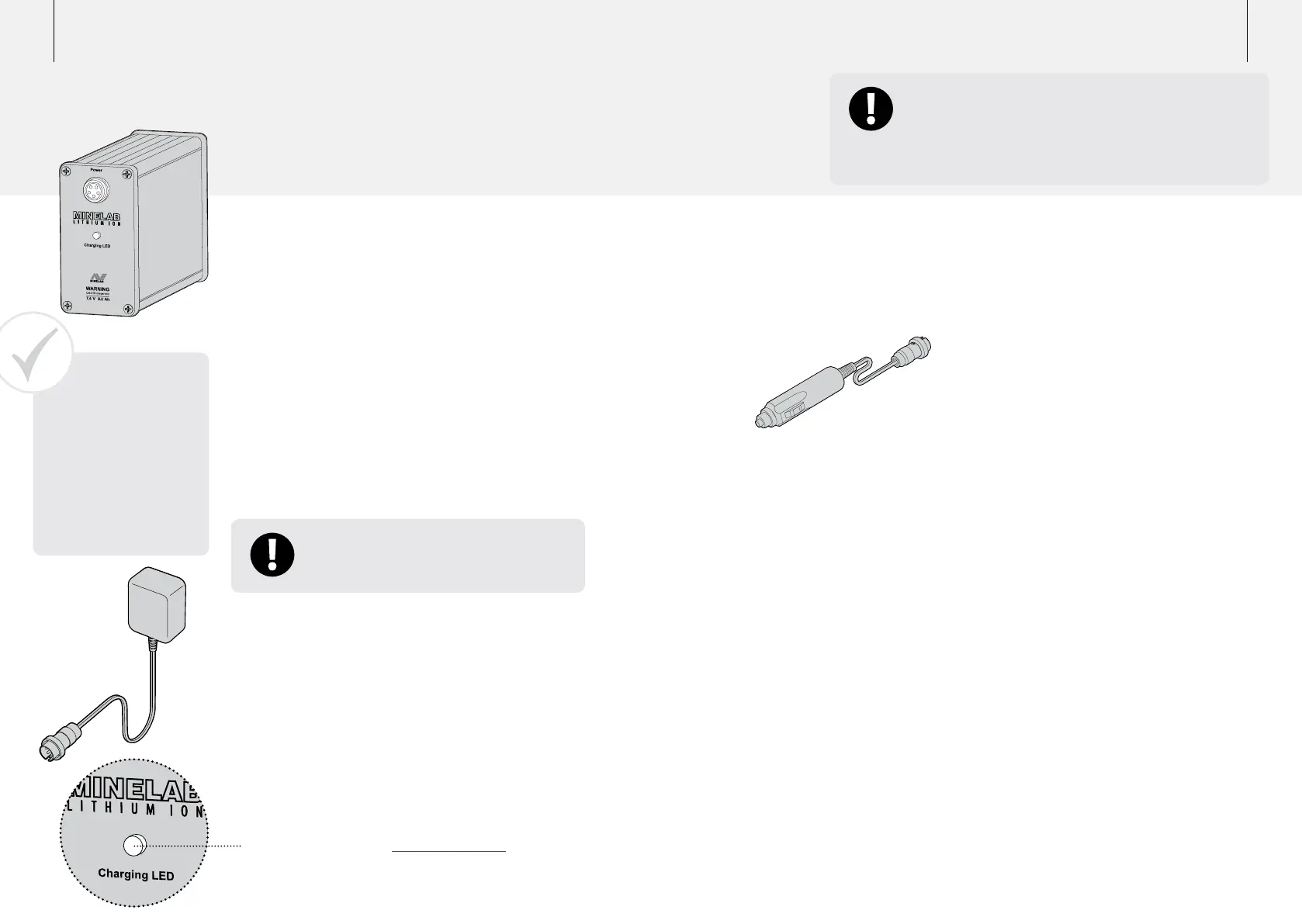18 19Charging the Battery
The aluminium battery case contains the 7.4V Lithium-
ion (Li-ion) battery pack and an internal charging circuit.
Supplied with the GPX 5000 and GPX 4800 is a mains
charger adaptor and a 12V vehicle charger adaptor.
When fully charged, the battery will provide enough power
to operate the detector for approximately 12 hours.
The charger will recharge a flat battery in approximately 5
hours, but partially discharged batteries require a shorter
recharge time. There is no need to fully discharge the Li-ion
battery before recharging, it can be recharged at any time
you are not detecting.
Note: Some after market coils can drain the battery at
a higher rate which may reduce your operating time by
up to 30%.
Vehicle Charger Adaptor
The vehicle charger adaptor will charge
the battery from the accessories socket
(cigarette lighter) of most motor vehicles.
The socket must be 12–24VDC.
Tip: A spare battery is
available as an accessory.
If travelling into remote
areas a spare battery will
ensure you can continue
detecting for long
periods of time.
To prevent damage to the battery, do not start the
vehicle's engine while the battery is connected.
Make sure your vehicle's battery is in good condition
before using it to charge the GPX Series battery.
Caution: The new battery should initially be
charged for 8 hours before use.
Mains Charger Adaptor
The mains charger adaptor will charge the battery from local
mains (AC) power outlets.
To Charge with the Mains Charger Adaptor:
1 Disconnect the power cable from the battery.
2 Connect the mains charger adaptor to the battery power
plug and the wall socket.
3 Switch the wall socket on.
The colour scheme of the tri-colour LED (p. 20) will indicate
the status of the charging process.
Lithium-ion cells are known to lose capacity
with time. This is due to the effect of two
factors:
Capacity Fade on Cycling
Degradation of capacity is particularly evident
if the battery is repeatedly charged and
discharged (as in normal use). This is a generic
phenomenon, known as capacity fade, and is
a characteristic of the electrochemistry of the
Li-ion system regardless of manufacturer or of
specific active materials.
Other very important contributors to capacity
fade are deep or over-discharge, and leaving a
battery fully discharged for long periods of time
before recharging. These conditions should be
avoided wherever possible to minimise capacity
fade and obtain optimum cycle life. Minelab
detectors shut down at a certain minimum
voltage of the battery in order to prevent
the battery being deep discharged. Also, the
battery pack itself has an electronic protection
circuit on board to prevent this from happening
in case of a short circuit when the battery is not
connected to the detector. Recharging your
battery shortly after draining it to nearly empty,
and not leaving it empty, will reduce this effect.
Shelf life
An older Li-ion battery will not last as long as a
new battery due solely to its age. This is due to
an increase in internal resistance, which affects
its ability to deliver current.
To Charge with the Vehicle
Charger Adaptor:
1 Disconnect the power cable from the
battery.
2 Connect the vehicle charger adaptor to
the battery and to the vehicle accessories
socket.
The colour scheme of the tri-colour LED (p.
20) on the battery will indicate the status of
the charging process.
Note: Don’t leave the battery on charge
in a closed vehicle on a hot day as it is
temperature protected and will stop
charging.
